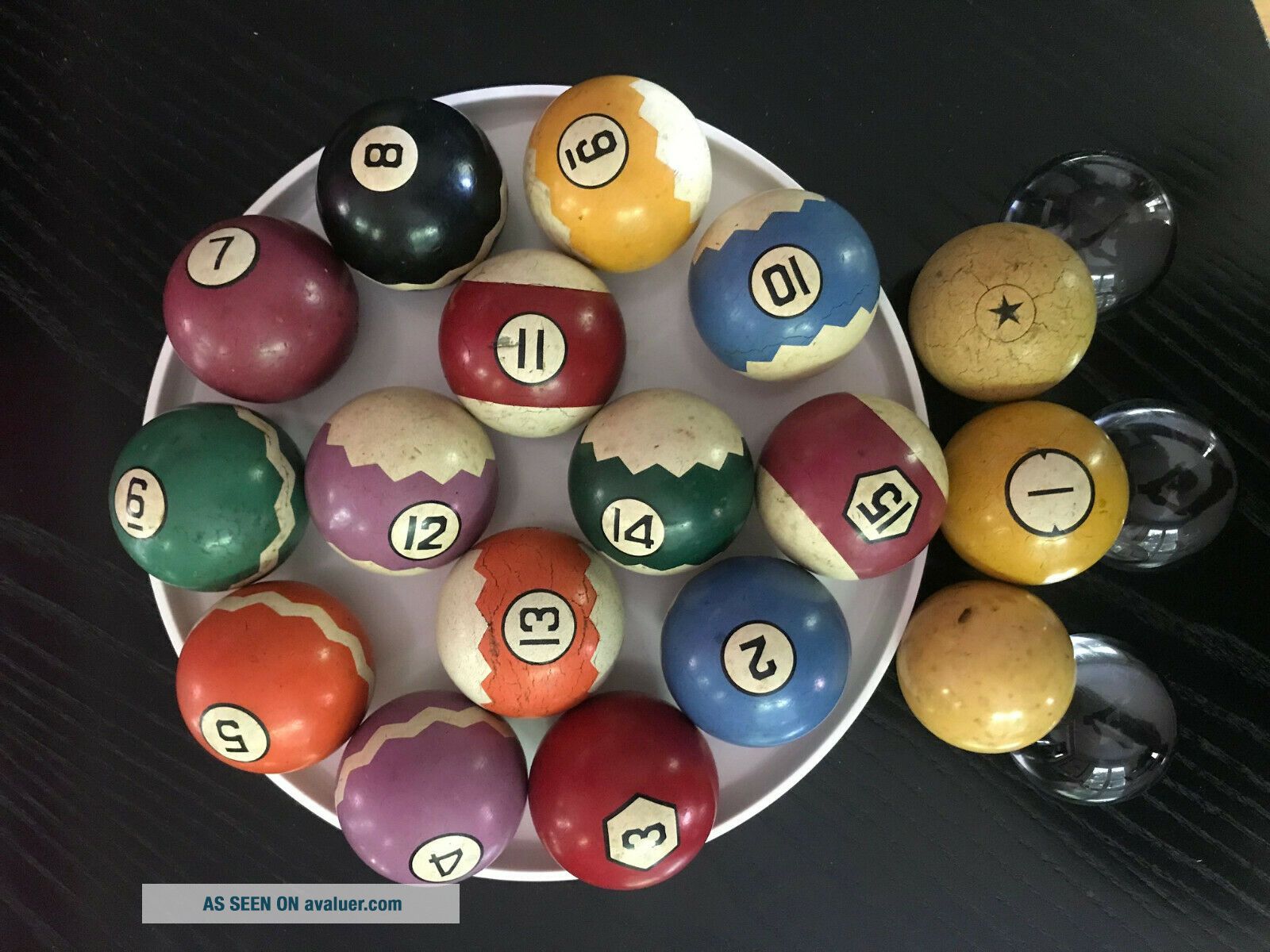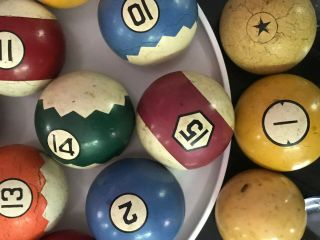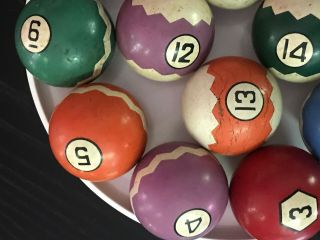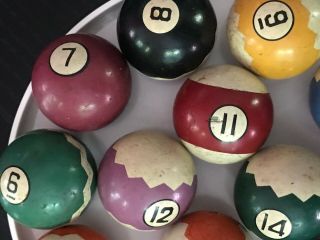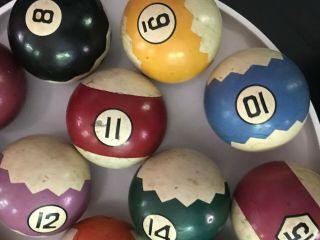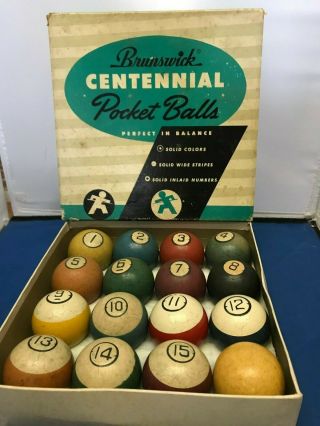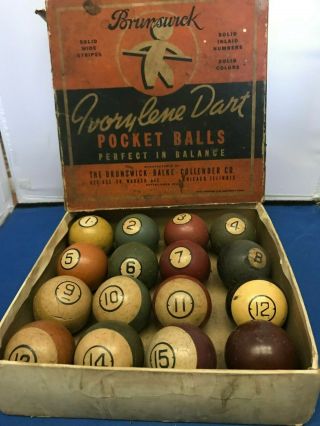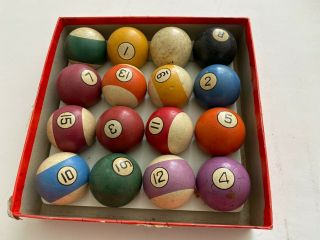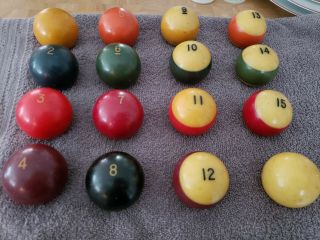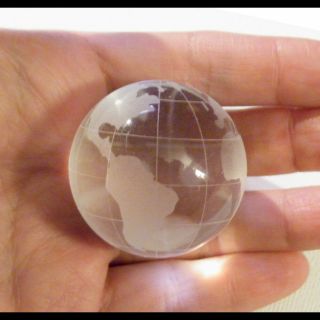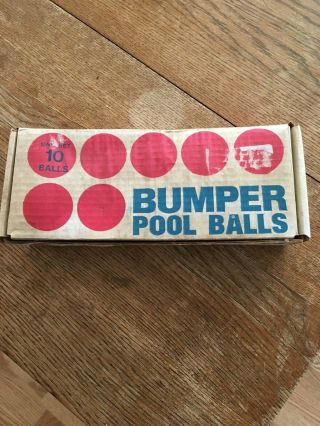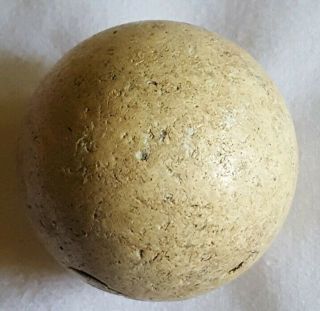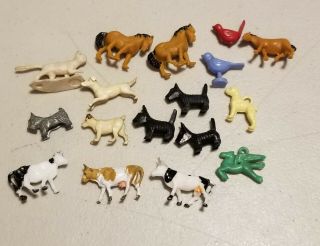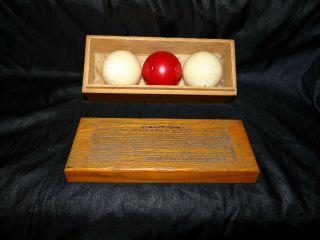Antique Vintage Pool Balls - 17 Assorted Inc Zig Zag, Others 2 1/4 " :1910 - 1940
Item History & Price
HeyEverybody - Found this collection of vintage pools balls!!Fromwhat I have discovered:Thesewere made between 1910-1925 approx. by The Albany Billiard Ball company.Thereare 11 balls from the super rare Hyatt zig zag pattern collection;#Cue, 2, 4, 5, 6, 8, 9, 10, 12, 13, 14 theother 5;#1, 3, 7, 11, 15I am alsoincluding:1 - other vintage cue ball as pictured.All together a total of 17 balls.Below is a bit of history I found:
The Albany Billiard Ball Company was an Americanmanufa...cturer of billiard ballsbased in Albany, New York.The company was founded in 1868, manufacturing for over 100 years, before goingout of business in 1986. HistoryIn the 1860s, John Wesley Hyatt of Albany, New York acquired British chemist Alexander Parkes's 1855 patent for Parkesine, anearly polymer, made of nitrocellulose, oil and various solvents. Parkes's own attempt to build abusiness around the new material, the first industrial plastic, had failed by 1868. Hyatt beganexperimenting with cellulose nitrate with the intention of manufacturing billiard balls, which until that time were principallymade from ivory (cheaper balls were made of clay or wood).Using cloth, ivory dust, and shellac, Hyatt devised a method of coveringbilliard balls with the addition of collodion in 1868. To manufacture the product, Hyatt formed the AlbanyBilliard Ball Company, in Albany, New York's South End in 1868, with assistance from Peter Kinnear andother investors. Hyatt received a patent onnitrocellulose innovation on April 6, 1869. The company initially operated outa machine shop owned by Kinnear, who ultimately became the majorityowner and steered the company to market and financial success. In 1870, John and his brother Isaiah patented a process ofmaking a "horn-like material" with the inclusion of nitrocelluloseand camphor, and founded a second business, AlbanyDental Plate Co. (later the Celluloid Manufacturing Co.), to manufacturemore than sporting goods. Alexander Parkes had used camphor among his Parkesine solvents, and anotherEnglishman who had worked with Parkes, Daniel Spill, listed camphor as an ingredient inhis own variant of nitrocellulose polymer, Xylonite, but it was the Hyattbrothers who recognized the value of camphor's use as a plasticizer fornitrocellulose. Isaiah Hyatt dubbed their material, using this method, Celluloid in 1872. It was put to use by the Albany Billiard Ball Company andits sister company, Albany Dental Plate Co. (later the Celluloid ManufacturingCo.) The name "celluloid" has long since become a genericized trademark.Albany's celluloid-based composite materialpool balls dominated the US market until the 1960s, when the increased availability ofcheap, imported balls almost ruined the company.***One man’s search for a better billiard ball pavedthe way for early plastics manufacturing, and Albany is where it began. In 1863a young printer named John Wesley Hyatt responded to a challenge by New Yorkbilliard table manufacturers Phelan & Collender. The company offered$10, 000 to anyone who could make a successful substitute for ivory billiardballs. Ivory had been the traditional material, but as it aged and dried theballs often cracked and became distorted in shape. Hyatt had earlier workedwith a material called collodion, a solution of nitrocellulose dissolved inalcohol, which he discovered solidified into a hard material. When mixed withcamphor, a compound called celluloid could be pressed in a mold to makebilliard balls. Instead of taking the $10, 000, Hyatt started his own company in1868, the Hyatt Manufacturing Company, which not only made billiard balls butalso dominoes, checkers, and even dentures.In 1875, the Scottish immigrant Peter Kinnear tookover the billiard ball manufacturing business and changed the name to AlbanyBilliard Ball Company. At the time, the factory was located on the southeastcorner of Grand and Plain Streets in Albany (now under the South MallArterial). Kinnear and others encountered one major problem: celluloid tendedto explode into flames. Fortunately, another early plastic developed by Hyatt, called bonsilate, was better suited for billiard balls. Made from finelyground bone and sodium silicate, bonsilate was sturdier than celluloid, heldcolor better, and did not burst into flames. Kinnear quickly adopted thecomposition as the primary material for his billiard balls.By the early twentieth century Albany BilliardBall Company relocated from its downtown operation to a larger factory on thecorner of Delaware Avenue and Whitehall Road. It remained in business until the1980s.One man’s search for a better billiard ball pavedthe way for early plastics manufacturing, and Albany is where it began. In 1863a young printer named John Wesley Hyatt responded to a challenge by New Yorkbilliard table manufacturers Phelan & Collender. The company offered$10, 000 to anyone who could make a successful substitute for ivory billiardballs. Ivory had been the traditional material, but as it aged and dried theballs often cracked and became distorted in shape. Hyatt had earlier workedwith a material called collodion, a solution of nitrocellulose dissolved inalcohol, which he discovered solidified into a hard material. When mixed withcamphor, a compound called celluloid could be pressed in a mold to makebilliard balls. Instead of taking the $10, 000, Hyatt started his own company in1868, the Hyatt Manufacturing Company, which not only made billiard balls butalso dominoes, checkers, and even dentures.In 1875, the Scottish immigrant Peter Kinnear tookover the billiard ball manufacturing business and changed the name to AlbanyBilliard Ball Company. At the time, the factory was located on the southeastcorner of Grand and Plain Streets in Albany (now under the South MallArterial). Kinnear and others encountered one major problem: celluloid tendedto explode into flames. Fortunately, another early plastic developed by Hyatt, called bonsilate, was better suited for billiard balls. Made from finelyground bone and sodium silicate, bonsilate was sturdier than celluloid, heldcolor better, and did not burst into flames. Kinnear quickly adopted thecomposition as the primary material for his billiard balls.By the early twentieth century Albany BilliardBall Company relocated from its downtown operation to a larger factory on thecorner of Delaware Avenue and Whitehall Road. It remained in business until the1980s.
The Albany Billiard Ball Company was an Americanmanufa...cturer of billiard ballsbased in Albany, New York.The company was founded in 1868, manufacturing for over 100 years, before goingout of business in 1986. HistoryIn the 1860s, John Wesley Hyatt of Albany, New York acquired British chemist Alexander Parkes's 1855 patent for Parkesine, anearly polymer, made of nitrocellulose, oil and various solvents. Parkes's own attempt to build abusiness around the new material, the first industrial plastic, had failed by 1868. Hyatt beganexperimenting with cellulose nitrate with the intention of manufacturing billiard balls, which until that time were principallymade from ivory (cheaper balls were made of clay or wood).Using cloth, ivory dust, and shellac, Hyatt devised a method of coveringbilliard balls with the addition of collodion in 1868. To manufacture the product, Hyatt formed the AlbanyBilliard Ball Company, in Albany, New York's South End in 1868, with assistance from Peter Kinnear andother investors. Hyatt received a patent onnitrocellulose innovation on April 6, 1869. The company initially operated outa machine shop owned by Kinnear, who ultimately became the majorityowner and steered the company to market and financial success. In 1870, John and his brother Isaiah patented a process ofmaking a "horn-like material" with the inclusion of nitrocelluloseand camphor, and founded a second business, AlbanyDental Plate Co. (later the Celluloid Manufacturing Co.), to manufacturemore than sporting goods. Alexander Parkes had used camphor among his Parkesine solvents, and anotherEnglishman who had worked with Parkes, Daniel Spill, listed camphor as an ingredient inhis own variant of nitrocellulose polymer, Xylonite, but it was the Hyattbrothers who recognized the value of camphor's use as a plasticizer fornitrocellulose. Isaiah Hyatt dubbed their material, using this method, Celluloid in 1872. It was put to use by the Albany Billiard Ball Company andits sister company, Albany Dental Plate Co. (later the Celluloid ManufacturingCo.) The name "celluloid" has long since become a genericized trademark.Albany's celluloid-based composite materialpool balls dominated the US market until the 1960s, when the increased availability ofcheap, imported balls almost ruined the company.***One man’s search for a better billiard ball pavedthe way for early plastics manufacturing, and Albany is where it began. In 1863a young printer named John Wesley Hyatt responded to a challenge by New Yorkbilliard table manufacturers Phelan & Collender. The company offered$10, 000 to anyone who could make a successful substitute for ivory billiardballs. Ivory had been the traditional material, but as it aged and dried theballs often cracked and became distorted in shape. Hyatt had earlier workedwith a material called collodion, a solution of nitrocellulose dissolved inalcohol, which he discovered solidified into a hard material. When mixed withcamphor, a compound called celluloid could be pressed in a mold to makebilliard balls. Instead of taking the $10, 000, Hyatt started his own company in1868, the Hyatt Manufacturing Company, which not only made billiard balls butalso dominoes, checkers, and even dentures.In 1875, the Scottish immigrant Peter Kinnear tookover the billiard ball manufacturing business and changed the name to AlbanyBilliard Ball Company. At the time, the factory was located on the southeastcorner of Grand and Plain Streets in Albany (now under the South MallArterial). Kinnear and others encountered one major problem: celluloid tendedto explode into flames. Fortunately, another early plastic developed by Hyatt, called bonsilate, was better suited for billiard balls. Made from finelyground bone and sodium silicate, bonsilate was sturdier than celluloid, heldcolor better, and did not burst into flames. Kinnear quickly adopted thecomposition as the primary material for his billiard balls.By the early twentieth century Albany BilliardBall Company relocated from its downtown operation to a larger factory on thecorner of Delaware Avenue and Whitehall Road. It remained in business until the1980s.One man’s search for a better billiard ball pavedthe way for early plastics manufacturing, and Albany is where it began. In 1863a young printer named John Wesley Hyatt responded to a challenge by New Yorkbilliard table manufacturers Phelan & Collender. The company offered$10, 000 to anyone who could make a successful substitute for ivory billiardballs. Ivory had been the traditional material, but as it aged and dried theballs often cracked and became distorted in shape. Hyatt had earlier workedwith a material called collodion, a solution of nitrocellulose dissolved inalcohol, which he discovered solidified into a hard material. When mixed withcamphor, a compound called celluloid could be pressed in a mold to makebilliard balls. Instead of taking the $10, 000, Hyatt started his own company in1868, the Hyatt Manufacturing Company, which not only made billiard balls butalso dominoes, checkers, and even dentures.In 1875, the Scottish immigrant Peter Kinnear tookover the billiard ball manufacturing business and changed the name to AlbanyBilliard Ball Company. At the time, the factory was located on the southeastcorner of Grand and Plain Streets in Albany (now under the South MallArterial). Kinnear and others encountered one major problem: celluloid tendedto explode into flames. Fortunately, another early plastic developed by Hyatt, called bonsilate, was better suited for billiard balls. Made from finelyground bone and sodium silicate, bonsilate was sturdier than celluloid, heldcolor better, and did not burst into flames. Kinnear quickly adopted thecomposition as the primary material for his billiard balls.By the early twentieth century Albany BilliardBall Company relocated from its downtown operation to a larger factory on thecorner of Delaware Avenue and Whitehall Road. It remained in business until the1980s.



